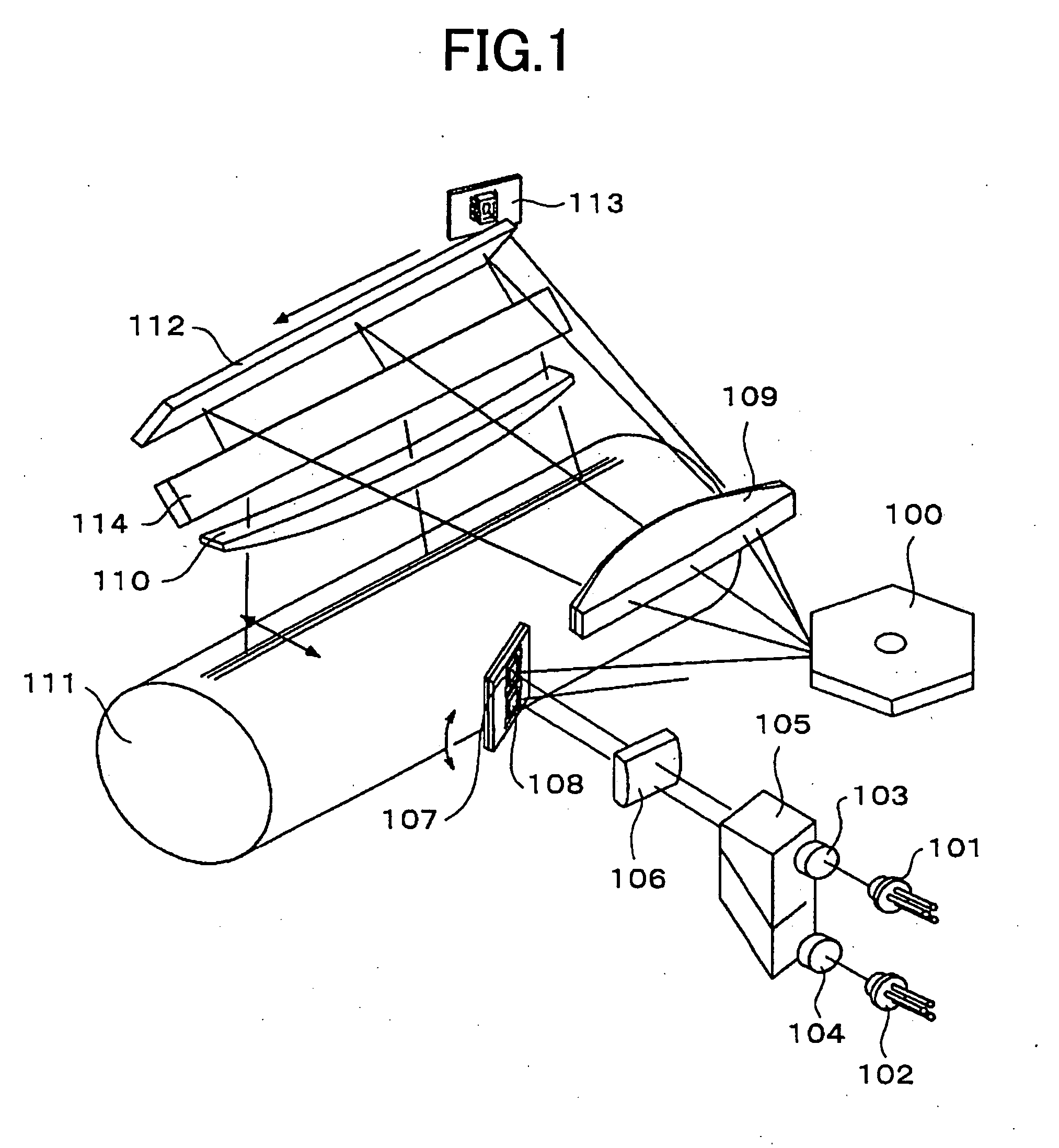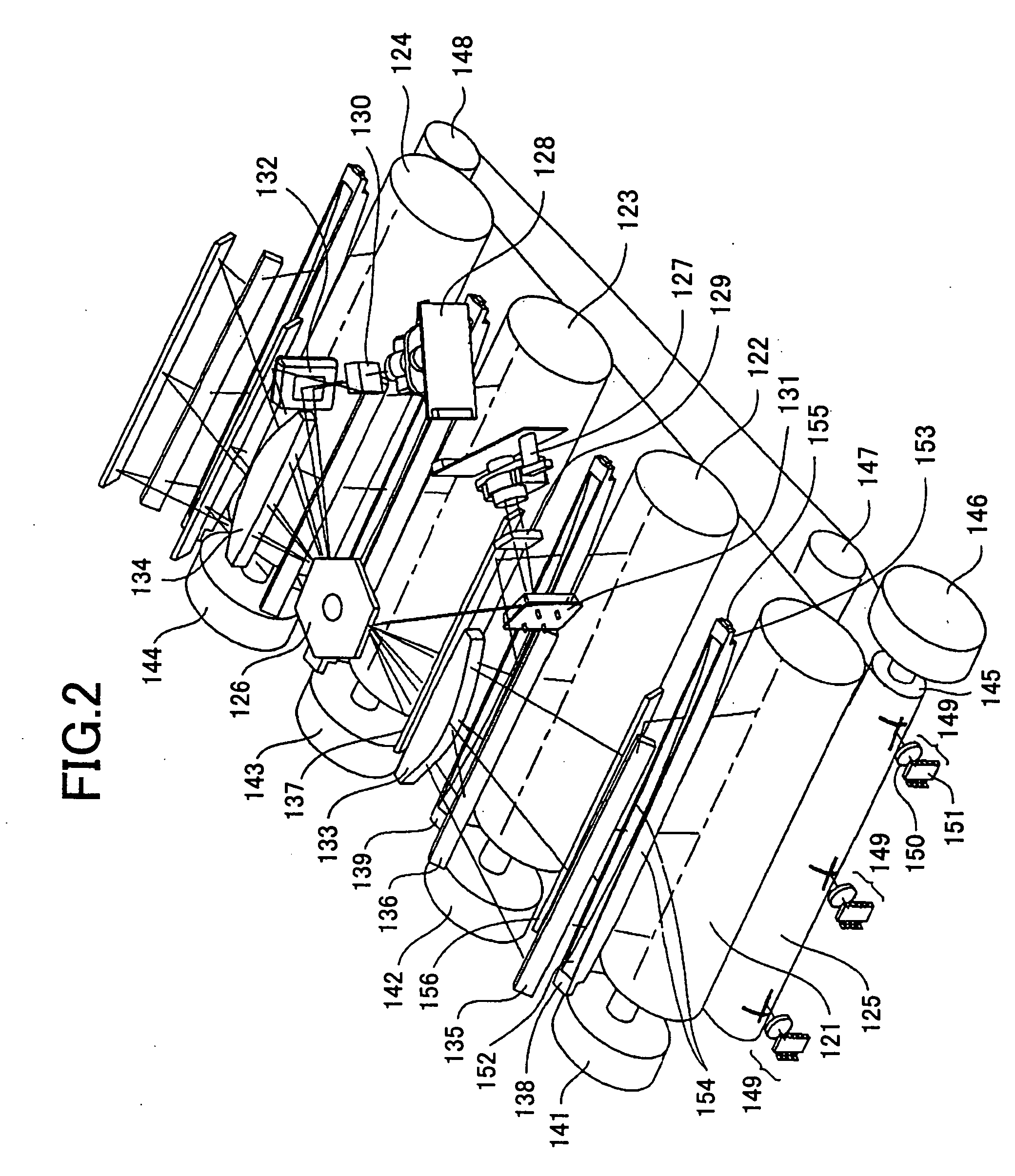If the photoconductor drum has an eccentric
rotational axis or a
drive motor for rotating the photoconductor drum has speed variations, the
latent image forming process through the transferring process cannot be completed at a uniform time.
As a result, a
pitch irregularity, that is, an irregularity of intervals (scanning pitches) between individual optically-written line images, arises in the sub-scanning direction of a transferred image, resulting in a density irregularity.
If the
pitch irregularity is caused in the tandem type color image forming apparatus, there is a risk that the individual superposed toner color images may be misaligned to each other.
In this case, a color displacement or a color change is generated in the formed multi-color image or the formed full-color image, resulting in degradation of
image quality.
In addition, a
pitch irregularity arises in the transferring part because of variations of shift speeds of a transfer belt as a transferred member and a carrier belt to carry transferred paper.
As a result, the density irregularity, the color displacement and the color change are caused.
This pitch irregularity is caused by eccentricity and rotational speed variations of drive motors for rotating the transfer belt and the carrier belt.
However, it is impossible to totally eliminate criteria of stable
machining and load changes of transmission systems.
As a result, it is impossible to totally eliminate the above-mentioned eccentricity and the rotational speed variations.
In the tandem type color image forming apparatus, if
optical scanners fail to uniformly align
resist positions of individual color latent images on the corresponding photoconductor drums with high accuracy, there is a risk that the produced color image may include color displacement and color change.
Additionally, when the
optical scanners write latent images by individual scanning lines, there is another risk that the scanning lines may have different slopes from each other.
However, it is impossible to prevent the influences exerted by the
low frequency factors due to the load variations and others that are involved in the eccentricity and
assembly differences in association with fabrication precision of parts thereof.
According to the above-mentioned methods, therefore, it is impossible to arrange dot positions of the individual images with high accuracy.
In contrast, the lens has disadvantages in that even if the curvature and gradient of a scanning line is initially adjusted, harmful curvature and gradient may arise because of deformation of the lens body due to temperature variations of the environment.
In particular, when a resin-molded lens is disposed away from a deflecting part, the stiffness of the resin-molded lens tends to be small because the lens is longer with respect to the main scanning direction.
As conventional methods, if one surface of the lens with respect to the sub-scanning direction is in contact with something to maintain the orientation thereof, there is a risk that the lens body may be deformed because the lens is retained in a condition where stress such as a warp and a torsion is imposed on the lens.
If the curvature of a scanning line is attempted to be corrected by forcibly curving a resin-molded lens in accordance to Japanese Laid-Open
Patent Application No. 10-268217, there is a risk that the
surface shape of the lens is deformed by
stress concentration.
If an
optical beam is deflected toward the
refractive index of interior of a lens whose distribution is centered at the optical axis thereof with respect to the sub-scanning direction in accordance with Japanese Laid-Open
Patent Application No. 11-064758, there is a risk that the
diameter of a beam spot is not uniform on a photoconductor drum.
As a result, there is a problem that the lens body is deformed and curved over time.
However, even if an optical scanner is initially adjusted to correct a difference between scanning positions, which can cause a difference between
resist positions, between individual image forming stations, there is a risk that temperature variations may deform the housing of the optical scanner and cause variations of the
refractive index of a scanning lens.
Therefore, it is impossible to avoid variations of resist positions over time.
For this reason, although the above-mentioned difference between resist positions is periodically detected and corrected, it is impossible to align the resist positions at the writing head of an image uniformly.
As a result, there is a risk that a difference between the resist positions, whose
maximum size is a half of the sub-scanning pitch, may appear on an image.
Additionally, if there is a speed difference between the transferring position and the detecting position due to speed variations of the transferred body, there is a risk that a detected resist difference may contain an error.
Thus, it is impossible to align the resist positions uniformly based on such inaccurate references even if the adjusting process is properly operated.
Additionally, the four-drum tandem type color image forming apparatus has another problem in that color displacement may occur when individual color toner images corresponding to the four photoconductor drums are superposed and transferred onto a
record paper.
If a plurality of optical beams are simultaneously used to write latent images on individual photoconductor drums, there is a risk that misalignment with respect to the sub-scanning direction may be caused corresponding to the number of prepared optical beams because a polygon scanner is not rotated synchronously with the photoconductor drums in general.
According to this invention, however, the adjustment mechanism becomes complicated and it takes a large amount of adjustment time.
In addition, since the heavy housings are adjusted, it is difficult to correspond to changes over time due to temperature variations.
Also, it is difficult to accurately correct color displacement during printing operation or color displacement due to variations of the environment.
According to this disclosed method, however, since the
galvanometer mirror is too sensitive for the purpose of controlling the
optical beam position of with respect to the sub-scanning direction, the
galvanometer mirror is highly influenced by external vibrations.
According to this color image forming apparatus, however, it is difficult to correct color displacement smaller than one line.
For instance, if individual simple color images are written at 600 dpi (
dots per inch), there is a risk that a full-color image generated from the individual color images may have color displacement of at least more than 42 μm.
 Login to View More
Login to View More  Login to View More
Login to View More 


